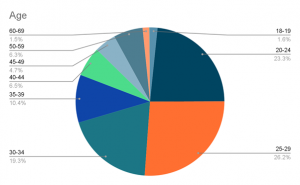What Happens When Strangers from 96 Countries Share a Home in Japan
TOKYO, JAPAN, June 23, 2025 /EINPresswire.com/ -- An Inside Look at One of Japan’s Most International Co-Living Networks
Living abroad for the first time often brings various challenges, particularly in countries where language and housing systems differ significantly from those in one's home country. In Japan, these challenges are well-known, especially for international residents unfamiliar with the language or culture.
OAKHOUSE, one of Japan’s largest co-living providers, offers a housing option that appeals to those navigating this unfamiliar environment. Founded in 1992, the company manages over 4,800 rooms across more than 200 properties in Tokyo, Osaka, Kyoto, and other cities. OAKHOUSE provides a wide range of options, from dormitory-style accommodations to private studio units, but it is the resident community that defines the company’s distinctive character.
Diverse, International Resident Base
According to internal data, approximately 66% of OAKHOUSE residents are non-Japanese, representing 96 different nationalities. Among these, residents from France and the United States are among the largest foreign groups, alongside individuals from other European and Asian countries.
Such international representation is rare in the Japanese housing market, where foreigners often encounter high entry barriers, including complex rental contracts, language limitations, and the need for a Japanese guarantor. OAKHOUSE has developed systems that reduce these burdens and encourage broader participation.
Mr. Katayama of the Sales Promotion Department, who has played a central role in developing OAKHOUSE’s co-living concept, explains that the company emphasizes daily communication and exchange among residents.
“We operate with the philosophy of ‘enjoy living’. More than 300 resident events are organized annually to encourage interaction.”
Resident Demographics
The majority of residents are in their 20s or 30s, with those aged 25–29 comprising the largest age group at 26%. The community also includes a range of older residents, including individuals in their 60s and 70s. For example, one current resident teaches at a famous university in Tokyo, while another previously worked as an executive at a global technology company.
Occupational backgrounds vary widely. Many residents are full-time employees, students attending language schools or universities, part-time workers, freelancers, and individuals on short-term work contracts. This broad range of experiences reflects the flexibility and accessibility of the co-living model that OAKHOUSE has cultivated.
English-Friendly, Multilingual Living
In many OAKHOUSE properties, English serves as a common language, allowing communication among residents from different countries. While Japanese remains the primary language in formal contexts, English is frequently used in communal spaces such as kitchens and lounges.
Staff members are generally able to assist in English, and residents often participate in informal language exchange sessions or cultural events. These interactions promote not only communication, but also community building across diverse backgrounds.
An Accessible Option for Foreign Residents
Compared to conventional rental systems in Japan — which may involve high deposits, complex paperwork, and long-term commitments — OAKHOUSE offers a simplified process. Contracts are designed to be flexible, and in many cases, new residents are able to move in within just a few days.
Although co-living may not be suitable for every individual, the model is increasingly appealing to those seeking a more social, international, and adaptable living environment.
For many, this housing option has provided more than just a place to stay — it has served as a starting point for building a life in Japan with a supportive community.
Nayun Choi
OAKHOUSE Co., Ltd.
email us here
Legal Disclaimer:
EIN Presswire provides this news content "as is" without warranty of any kind. We do not accept any responsibility or liability for the accuracy, content, images, videos, licenses, completeness, legality, or reliability of the information contained in this article. If you have any complaints or copyright issues related to this article, kindly contact the author above.
Rhombus University Celebrates 2025 Graduates with Online Commencement Ceremony
'Trust Nothing, Verify Everything': Rise of AI-Powered Scams Signals New Digital Threat Era
The Seminara Group at Morgan Stanley & Twin Bridge Sports Host First-of-Its-Kind NIL Powered Financial Literacy Webinar
Więcej ważnych informacji
 Jedynka Newserii
Jedynka Newserii

 Jedynka Newserii
Jedynka Newserii

Handel

1 października ruszy w Polsce system kaucyjny. Część sieci handlowych może nie zdążyć z przygotowaniami przed tym terminem
Producenci, sklepy i operatorzy systemu kaucyjnego mają niespełna dwa miesiące na finalizację przygotowań do jego startu. Wówczas na rynku pojawią się napoje w specjalnie oznakowanych opakowaniach, a jednostki handlu powinny być gotowe na ich odbieranie. Część z nich jest już do tego przygotowana, część ostrzega przed ewentualnymi opóźnieniami. Jednym z ważniejszych aspektów przygotowań na te dwa miesiące jest uregulowanie współpracy między operatorami, których będzie siedmiu, co oznacza de facto siedem różnych systemów kaucyjnych.
Ochrona środowiska
KE proponuje nowy cel klimatyczny. Według europosłów wydaje się niemożliwy do realizacji

Komisja Europejska zaproponowała zmianę unijnego prawa o klimacie, wskazując nowy cel klimatyczny na 2040 roku, czyli redukcję emisji gazów cieplarnianych o 90 proc. w porównaniu do 1990 rok. Jesienią odniosą się do tego kraje członkowskie i Parlament Europejski, ale już dziś słychać wiele negatywnych głosów. Zdaniem polskich europarlamentarzystów już dotychczas ustanowione cele nie zostaną osiągnięte, a europejska gospodarka i jej konkurencyjność ucierpi na dążeniu do ich realizacji względem m.in. Stanów Zjednoczonych czy Chin.
Handel
Amerykańskie indeksy mają za sobą kolejny wzrostowy miesiąc. Druga połowa roku na rynkach akcji może być nerwowa

Lipiec zazwyczaj jest pozytywnym miesiącem na rynkach akcji i tegoroczny nie był wyjątkiem. Amerykańskie indeksy zakończyły go na plusie, podobnie jak większość europejskich. Rynki Starego Kontynentu nie przyciągają jednak już kapitału z taką intensywnością jak w pierwszej części roku. Z drugiej strony wyceny za oceanem po kolejnych rekordach są już bardzo wysokie, a wpływ nowego porządku celnego narzuconego przez Donalda Trumpa – na razie trudny do przewidzenia. W najbliższym czasie na rynkach można się spodziewać jeszcze większej zmienności i nerwowości, ale dopóki spółki pokazują dobre wyniki, przesłanek do zmiany trendu na spadkowy nie ma.
Partner serwisu
Szkolenia

Akademia Newserii
Akademia Newserii to projekt, w ramach którego najlepsi polscy dziennikarze biznesowi, giełdowi oraz lifestylowi, a także szkoleniowcy z wieloletnim doświadczeniem dzielą się swoją wiedzą nt. pracy z mediami.






![Nestlé w Polsce podsumowuje wpływ na krajową gospodarkę. Firma wygenerowała 0,6 proc. polskiego PKB [DEPESZA]](https://www.newseria.pl/files/1097841585/fabryka-nesquik_1,w_85,r_png,_small.png)




.gif)

 |
| |
| |
|